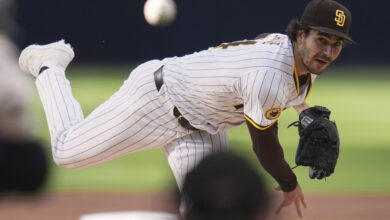
All About the D: According to FanGraphs, Cubs Have the Best Defense in Baseball
The topic of this post should really come as no surprise, what with the Cubs already being accepted as the greatest assemblage of talent in the history of forever. The legendary status of this team, however, tends to be driven mostly by how their offensive prowess causes jaws to drop and tongues to wag. Oddly enough, Kris Bryant’s eyes have that same effect. Addison Russell’s too. And each time Anthony Rizzo drops to one knee to blast another home run, fans can’t help but swoon as they say, “Yes!”
But a funny thing happened on the way to building a juggernaut: the Cubs actually put together a team that can stop runs as well as it scores them. Mind. Blown. Okay, not really. We all — at least those of us who understand that batting average and RBI are not the true measure of a man — knew that Jason Heyward was signed as much for his glove as his bat. And Russell taking over full-time at short was sure to yield results. Even Kris Bryant, whose defense at third was given short shrift prior to last season, has acquitted himself quite well at the hot corner.
Add in Dexter Fowler’s revelatory performance in center, Rizzo’s solid play at first, and Javy Baez’s ability to play plus D all over the infield, and you’ve got yourself a pretty solid squad. The Cubs were actually pretty good in the field last season, but the improvements have been evident even at this early juncture. As you can see from the chart below (full definitions of the various categories available at the end of the post), most of the league is looking up at the Cubs in several different metrics.
I think you all know better by now than to invest a great deal of credence in early-season numbers, particularly those that measure defensive performance. But that doesn’t mean we can’t see some really positive trends at work here, particularly in the error runs column. If there’s one thing that drives you crazy as a fan, it’s seeing your team give away runs and games due to miscues. What we’re seeing thus far is that the Cubs aren’t beating themselves, which is a nice change.
Of course, as I was typing that last bit — literally, as I was in the middle of a sentence praising the fact that the Cubs don’t give away runs — Russell misplayed a grounder hit right at him to allow the Braves to score. While I believe the young shortstop will eventually be a great offensive weapon as well, his real value comes in providing a premier glove at a premium position. That importance was underscored by a quirky little stat making the rounds Sunday evening.
The Cubs are 8-1 when Addison Russell goes hitless but 0-3 when he commits an error. It's all about the D with this team.
— Uncle Jeff (@ebsoftball) May 2, 2016
Yes, Jeff, it truly is all about the D.
One area that’s surprisingly lagging given the personnel changes, however, is outfield arm runs, a mark that appears to have dropped off significantly. Then again, only 11 teams are better than zero in this category and there’s a lot of time left for Jason Heyward to throw out a few more runners and bump that number up a bit. Heyward’s ability to cover all kinds of ground has also contributed mightily to that range runs number and has likely made some teammates better.
It’s gotta be nice as a pitcher to know that the guys behind you can really pick it like that.
As the Cubs get further into the season and start facing more difficult competition, limiting extra bases and runs is going to become ever more important. After all, the hitters can’t put 15 runs on the board every game. So while we all dig the longball, this team is out to prove that the D can just as surely bring the “Oh,” not to mention a few W’s.
ARM (outfield arm runs): Outfielder’s [sic] get credit (plus or minus) depending on what the runners do on a hit or a fly ball out. A runner can stay put, advance, or get thrown out. A fielder will get credit not only if he throws out more than his share of runners, but also if he keeps more than his share of runners from advancing extra bases.
DPR (double play runs): The number of runs above or below average a fielder is, based on the number double plays versus the number forces at second they get, as compared to an average fielder at that position, given the speed and location of the ball and the handedness of the batter.
RngR (range runs): The number of runs above or below average a fielder is, determined by how the fielder is able to get to balls hit in his vicinity.
ErrR (error runs): The number of runs above or below average a fielder is, determined by the number of errors he makes as compared to an average fielder at that position given the same distribution of balls in play.
UZR (ultimate zone rating): The number of runs above or below average a fielder is in both range runs, outfield arm runs, double play runs and error runs combined.
Def (defense) is the combination of two important factors of defensive performance: value relative to positional average (fielding runs) and positional value relative to other positions (positional adjustment).


